
58 minute read
CHAPTER I
CHAPTER I
CULTURAL AND IDEOLOGICAL DAWN OF ALBANIAN SCULPTURAL ARTS
Advertisement
The pagan imaginations of the Azerbaijanis ancient ancestors had a decisive influence on the engendering and development of the ancient plastic arts. Those imaginations were described most fully by the Albanian historian Movsēs Dasxurançi (“The History of Caucasian Albanians” B. 1993), Yusif Vazir Chemenzeminli (“Maiden’s Spring” B. 1964), M.Seyidov (“Thoughts about ethnogenesis of Azerbaijani people” B. 1989), B.Abdullah (“Azerbaijani ritual folklore and its poetics” B. 1990) and many other authors. The works of famous turkologists L.N. Gumilev, S.T.Yeremeyev and, certainly, the works of the classics of world religious studies and ethnography – E.B.Taylor, J.Fraezer, M.Eliade, P.Florensky, etc., are dedicated to the reconstruction of pagan ritual practice and are used as a methodological basis for any researches dedicated to ancient ulture and art.
It is clear that all the cultural manifestations of pagans were based on ideology, displayed in different cults and rituals. The art, including sculptural arts, was an integral part of these rituals. But on the other hand, all these beliefs (and not only the Cro-Magnons, but also many other tribes and peoples known both to ethnologists, and to archaeologists) had not yet formed religion as phenomenon, correlated with art, mythology, science and differed from them in the same time. This ancient syncretical foreculture did not set apart the art, science, literature, philosophy, etc., through its own system. Besides, that foreculture did not separate religion from them. To be more exact, the religious elements were merged with other elements of the spiritual and ceremonial culture and formed a single and indivisible whole. According to pagan imaginations the world was divided into 3 main zones: the upper zone (the sky with the Polar Star in the center), the middle zone (the land surrounded by ocean waters), the lower zone (the afterworld of cold and darkness). The world axis is either tree or a mountain. The supreme God and the highest deities are the inhabitants of the upper zone, the minor deities and most of the spirits are placed in the middle zone, the forces of evil are placed in the lower zone. This is most general and fundamental panorama of the world (cosmos), it’s actualized according to the cyclical principle, it is realized and concretized in pagan ritualism, ceremonies and mythopoetic thinking. All these peculiarities were manifested in concrete cults, accompanied by the creation of architectural structures, sculptures and various kinds of religious and everyday life objects. These objects materialized separate fragments of this general picture of the world. In
this chapter the most spread cults in which the creation and participation of sculptural arts was of high-priority are studied.
Bronze figurines. Birds. 1st millenium B.C.
The cult of foremother
The engendering of one of the most ancient cults - the cult of the great mother was documented in the late Paleolithic period already (Orignac). Numerous Orignac “Venus”es, including the famous Villendorf (is kept in Vienna Historical Museum) is dated from XX millenium B.C.
Numerous statuettes of small size (6-12 cm), carved out of stone and found all over the world confirm the universal character of the Great Mother Goddess cult as early as the Stone Age. Archeology presented remarkable evidences of the Mother Goddess cult universal spreading in Stone Age period. In the vast territory from the Pyrenees to Siberia female figures carved from stone or bone are found to the present day. All these images, the most ancient of which are found in Austria, are conditionally called “Venus”. The “Venus”es are united by one important feature - their hands, feet, face are marked barely.
The main things, attracted the primitive artist are the organs of childbirth and feeding. It was suggested that the ancient women, alike the women of some modern primitive tribes, had in reality such enormous breasts and pendulous belly.
But if we admit that in “Venus” only the aspire to realism was reflected its possible to suppose that primitive women had no face and their hands were of bite-size. In some cases, the emphasis of the female body features exceeds the limits even of caricature, and the statuette transform into female headless torso, in which the breasts and thighs are particularly accentuated.
Finally, the last limit of simplification is a statuette representing the breasts only. So, it is the mark of female pure activity - giving birth and feeding without the slightest hint of thinking. This is the oldest embodiment of the idea of
“eternal femininity.” The key of the extraordinary features in the “Venus” figures lies in the fact that to researchers mind they were cult images. It is nothing more than idols or the Mother Goddess amulets .
Having absorbed much of the ancient totemistic ideas, the cult of fertility, as though merged together the fertility of the land, the reproduction of livestock and the fertility of woman -mother. Worships were performed most often in spring, sometimes in autumn and were usually accompanied by lush ritual celebrations in honor of the deities and spirits related to this cult.
Rituals and ceremonies were colorfully framed with phallic emblems and symbols. The emblems and symbols should emphasize the significance of the male fertilizing and feminine fruity beginnings and the great creative potencies of their juncture.
Among the symbols are talked about were kauri shells, which resembled a vulva by their form and were highly valued as a life-affirming amulet. Among those symbols ceramic figures of women with accentuated sex characteristics were also. Those symbols were widespread among Neolithic farmers, and figures of women with an infant in their arms were met also (although less often).
Finally, the same symbolic in abundance is found in the ornamental painting of containers. Among those paintings we can see a lot of oval or triangular images of the vulva, schematic pictures of the rain, fertilizing the earth, etc.
In course of time the cult of fertility, reproduction, fertilization was reflected in mythology, e.g. in the legends powerful deities began to appear more and more often. Those deities got a male or female appearance, contracted marriage relationships with each other, etc. Sometimes those relationships were quite complicated and were rich by various adventures, deceptions, reincarnations and many other folklore details. Mythological plots describe the connection of God with a woman particularly generously. The

Situla. Bronze. Mid. 1st millennium B.C. Mingechevir
Bronze staff in the shape of a bull’s. IX century B.C. Karabakh region

roots of that imaginary connection go back to totemism and from that connection legendary heroes were born. Later, those legendary heroes became the forefathers or rulers of one or another ethnic community.
Along with petroglyphic paintings, cave sanctuaries and burials, female figurines are important sources of information about the spiritual world of people in Paleolithic era. Those figurines emphasized the reverential fear of our ancestors both in front of the secret of life and the secret of death.
Female figurines demonstrate that a person’s will to life was expressed and asserted itself in a variety of rituals and myths even at very early stages of human history. Those myths and rituals are commonly associated with the widely spread belief that the dead can return to life through a new birth.
The rituals were supposed to be attempt, organized by community in order to take control over natural forces and processes with the help of supernatural means for the universal good. That sacred tradition, connected with the extraction of food, the secret of birth and reproduction and death, engendered and acted, apparently in answer to the desire to live both now and in the future.
All these cave sanctuaries, figurines, burials and ceremonies were associated with the belief in the existence of that single source from which both human life and the life of animals and plants originate. That source is the Great Goddess Mother, or the Giving All. The image of Great Goddess Mother will be met even in later periods of civilization history.
They also give reason to believe that our ancient ancestors understood very important thing:the humans and the Nature surrounded them were closely interconnected parts of the great mystery of life and death, and therefore all of nature should be treated with respect.
Later this realization was emphasized by the fact that the Goddess figures were placed among figurines symbolizing the nature, animals, water and trees. “She Herself”- Goddes was also pictured as a half-animal and half-human, apparently, it was central image in the spiritual heritage which was lost later.
The awe and amazement of the great miracle of human existence was also important moment here. It was reverential awe the miracle of all life, miracle for birth, embodied in the female body.
Andre Leroy-Guran, director of the Center for Prehistoric and Protohistorical Studies at the Sorbonne is the author of one of the most important contemporary works dedicated to the art of Paleolithic. In his works the well-known scientist wrote that it would be “absurd and not enough” to reduce the belief system of that period to a “primitive fertility cult.”
A.Leroy-Guran also asserted that “we can receive without exaggeration all visual art of the Paleolithic in whole as expressing of views on the natural and supernatural organization of the living world.” Then Leroy-Guran continued, that “people of the Paleolithic era undoubtedly knew about the division of the animal and human world into two opposing halves and believed that the world of living beings is ruled by the union of these halves. “ (44.118-120)
It would be natural to suppose, that external dimorphism, or differences in appearance between the two halves of humanity, had very great influence on the Paleolithic belief system.
Another assumption is also natural and logic. It’s based on realization that the life of both man and animal arises from the body of the individual Female; the female organism, alike the seasons and the Moon, is subordinated to cyclicity. That assumption forced our ancestors to embody the life-creating forces not in the masculine form, but in the feminine one.
So, Paleolithic female figurines, cowry shells, red ocher are not isolated archaeological objects, but they are early manifestations of phenomenon, developed later into a complex religious system. In the center of that religious system the cult of the Goddess Mother, the Founder of all life was placed.
In the pagan Azerbaijan, “Mother Earth” expression had not only a metaphorical meaning. It signified the soul of nature itself, the goddess, the wife of the Master of Heaven (Tenqri).
The formation of the female image of supreme deity in the ideological ideas of our pagan ancestors has been consistently observed in period from the Neolithic era (8-6 millenium B.C.). It is seen at all stages of their development until the establishment of monotheistic ideas about the world.
The rich archaeological material indicates the presence of this cult in the prehistoric past of Azerbaijan and it’s strong influence on the formation of traditions and stereotypes of pagans. This fact is confirmed by the great number of sculp-

Bronze figure. III-I century B.C. Lekit-Kotuklu villages. Qakh region

Bronze figure of a ram. III-I centuries B.C. Mingechevir. tures and images of the GREAT MOTHER on religious and everyday life objects, which were made up to the early Middle Ages.
Religious imaginations of each society always had great influence over its social life. The character of deity and of the afterworld is projected unavoidably on the everyday existence of human being. We can say, that everything, which is characteristic for celestial matter will be identical to the earthly one or aspires to become so. Therefore, the concept of God inevitably forms certain stereotypes, connected with society itself.
While more detailed analysis of patriarchal and matriarchal cultures, we can fully realize this fact easily. We are talking about differences in attitudes towards men and women, about the primacy and priorities and the role and functions of men and women in different traditions and cultures. The image of a female deity forms other traditions and other relations than in the case when the God-man is the dominant figure.
There are many different cultures in which deities come before us in a female form. For some cultures, female deity is of top-priority one and acts as the supreme god. In the same time, female deities often are represented on a par with other male gods and do not bear any differential functions of supreme deities.
The image of the Mother Goddess is most remarkable example of female supreme deity. The mother goddess is the main female deity in many mythologies of the world. As mentioned earlier, the Upper Paleolithic statues of women with emphasized sexual characteristics are the earliest evidence of the existence of Mother Goddess cult and worship.
Later imaginations about the Mother Goddess are associated with the ideas of the primordial divine couple. In that couple the deities were the ancestors of the universe and of all creatures, inhabiting it.(44.67).
The main function of the Mother Goddess is the creative function, which includes:
- participation in the creation of the world; - participation in the creation of all living beings; - protection of fertility; - patronage of culture, laws, secret knowledge.
The well-known anthropologist J.Frazer, who was standing at the origins of modern religious studies, in his work “The Golden Branch” wrote
that of the phenomenon of endowing the deity by human signs belonged to an early period of religion history .
“No matter that the idea of a god embodied in human form seemed very strange. But for a primitive man, he saw in man-God or in God-man only a higher degree of the same supernatural abilities presence. So, he confessed those abilities to himself without remorse and there was no nothing out of the ordinary “(66.117).
Basing on Fraezer’s observations, we can say that the cult of the mother goddess is a result of the deification of women.
To Fraezer’s mind, the embodiment of gods in living people can be:
1. Temporary, which expresses inspiration, obsession and manifests itself in supernatural knowledge (prophecies, predictions) 2. Constant, expressed in the performance of miracles - as an unusually strong manifestation of ordinary ability.
The moment of sacral functions transfer from women to men is very interesting. Mircha Eliade told about the existence of mythic traditions that indicated the important role of women in religious life in early times (73.191).
Gradually, the secret knowledge and rituals which initially belonged to women passed to the male part of the population by means of theft. M. Eliade stresses the importance of accepting by mythological women the consequences of theft and the transfer of sacred forces into the hands of men (73.196).
Mother Goddess rules all processes of nature. It is she who makes come to life the seed, sunk
Golden statuette. Mid. 1st millennium B.C. Lenkoran
Bronze bird figurine. III-I centuries B.C. Chovdar. Khachbulag.

in the ground; she injects love in people and animals, bird sing songs in the days of spring courtship for Her. At her wave, flowers bloom and fruits are poured. Her joy is the joy of all living things; her eyes look at us from the sky blue, her hand gently caresses the foliage, she rushes over the world in the breath of the spring wind.
It becomes clear that in ancient times (in some nations) priestly functions belonged primarily to women. E.g. among the North Indians, conjurations were performed by women. Some Indians have a legend that “fertility rites” were instituted by women.
According to one Iroquois legend, the first woman, the founder of agriculture, when dying, legated to drag her body along the ground. The places, where her body touched the soil, a bountiful harvest grew. The shaman and priestess are known in the most primitive cultures. In places, where this phenomenon has already disappeared, we can find its marks.
E.g. in Chukchee and other northern peoples while performing rituals, a man-shaman dressed women’s clothes. The mysterious frescoes of the Crete island also demonstrate that in the most sacred moments the man had to dress women’s costume.
A woman is alive embodiment of world Mother. Who should keep in the hands the secrets of the cult except her? Doesn’t she have in her body the secret of birth? The primacy of women in religion was observed in religion of the Gauls, the ancient Germans, and many other nations. The cult of fertility, which stood at the origins of the religion of Dionysus, was also headed by priestesses. Numerous folk beliefs about magicians, fortune-tellers and witches are only an echo of those ancient times when all rituals, e.g. sacrifices, spells and magic were gathered in the hands of women.
It is quite natural that having such an important cult significance women often found themselves in the role of chiefs and leaders of a tribe.
All feminine divine images are a kind of one goddess, and this goddess is the female principle of the world, one sex raised to the absolute.
Bronze. Fantastic fish. Baku. 3-1st centuries B.C.
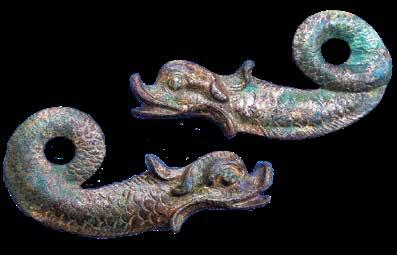
“Mother Goddess is the universal mother. All plants, animals, people came out from her bosom. Therefore, in primitive man thinking there is a feeling of kinship that connects all living beings.” (20.117-123)
The earliest stone sculpture of a woman discovered in Azerbaijan is dated from the Mesolithic era. It was discovered in Gobustan in the “Kenize” settlement (49.41). The character of the picturing of this sculpture is identical to the


Paleolithic “Venus” described above. The deficiency of the head and facial features working, exaggerated picturing of the breasts, belly and hips indicates the universality of the ideological “canons” that gave rise to similar sculptural images throughout the world.
The number of female statues of the Neolithic era is a lot more. The engendering and development of agriculture in the late Mesolithic and Neolithic era, the formation of matriarchal foundations of primitive societies gave rise to a developed cult of the Mother Goddess, reflected in the sculptural images.
Bronze pendant in the form of a deer. III-I centuries B.C. Molla Isakly village. Ismayilli region.
Bronze mirror. VII-IV centuries B.C. Mingechevir
Bronze pendant in the form of a ram. III-I centuries B.C. Molla Isakly village. Ismayilly.

A great number of Neolithic women figurines were found in the settlements of “Shomu-tepe”, “Gargalar-tepe” (Kazakh region), “Ilanly-tepe” (Karabakh region), “Tepe-Sarob” (South Azerbaijan) and others. All these small figures are made of burnt clay and bear the marks of rituals, connected with the increase of fertility.
The figurine from “Shomu-Tepe” (Kazakh) is visual evidence of this fact. On the femurs and the belly of this figure there are squeezed marks of wheat grains. There is no doubt that at the time of making the figure it was run in wheat in order to increase its fructifying power.
The number of clay figurines of women in Azerbaijan decreases sharply in the Bronze Age (3-2nd millenium B.C.). This fact can be explained by the replacement of matriarchate by patriarchy and the increasing role of men in society.
The last burst of female figurines development in the pagan era falls on the Albanian period in the history of Azerbaijan (4th century B.C. - 7th century CE)
Earthen figurines of this period were found in Molla-Isakly (Ismayilli region), Chukhur-Gabala (Gabala region) Khynysly (Shemakha region) and many other settlements of pagan Albania.
All the sculptural images of women, mentioned above allow to reconstruct the role of female figurines as a deity which provide fertility. This fact is also confirmed by the places where these clay figurines are found, e.g. the absolute majority of these figurines are found either at the fireplace or at the entry of the dwelling.
None of the statuettes have any marks of aestheticization in the image of a woman. In these figurines heads, facial features are often away, almost all of them are made without clothes, as a goddess and not an earthly woman must be pictured.
Comparison of the typological features of most these figurines prove the universality of main form making principles in creating such figurines, regardless of the region. The differences are most likely associated with local stylistic differences, manifested in the methods of modeling, molding or decorating figurines. The identity of statuettes from Southern Azerbaijan (Tepe-Sarob), Syria and Turkmenistan is obvious sample of it.
Analogies of Azerbaijani statues are viewed easily and can be observed not only in ancient-eastern civilizations, but also in more northern ones (such as Ukraine (Tripolye). Such analogues let express the idea of the most ancient ethno-cultural community of the inhabitants of southern Ukraine (Tripolye), the Black Sea basin (Anatolia) and the South Caucasus. It’s logical supposition, because
Neolithic figurines found in these regions have striking similarities both in nature and in form.
In differ from the Paleolithic and Mesolithic sculptures, which are often made of stone, in clay sculptures of the Neolithic era the tattoo appears. Such tattoo covers mainly the parts of the body, connected with childbirth and indicate the performing of magical rites associated with childbirth and fertility.
In the Albanian period (4th century B.C. - 7th century AD), the tattoo is replaced by apotropic stuccos, which symbolize the abundance of the female seed and the protection of the reproductive and the feeding organs (groin, belly, breasts).
Summing up the part, we can say with certainty that the image of the Mother Goddess was universal one for all ancient civilizations. As for their plastic characteristics, it is evident, that they had local features dictated by the peculiarities of ideological canons, methods of modeling and decorating statuettes.
The cult of the fathers (ancestors) - the patrons of the kin


Cult of ancestors is one of the most strongly pronounced animistic cults. It is preserved in many nations of the world to this day (worship of the souls of deceased relatives). The spirits of ancestors in ancient Azerbaijan had always been given certain honors and attention. Here periodically sacrifices were made, in the same time belief in their constant patronage always existed.
The forms of ancestors cult manifestation are very various. The funeral ritual was also performed in different ways. The bodies of the dead were buried in the ground, cremated, etc. The mythology of the Turkic peoples is replete with plots, connected with imaginations about the matter of death, imaginations about the relationship of the spirits of the dead ancestors with living people.
Thus, the Turkic peoples believe that the ghost, which left the human body forever, wan-
Bronze figure in the form of a crow. III-II centuries B.C. Nargizava, Agsu.
Bronze pendant in the form of a horse and rider. III-I centuries B.C. Nargizava, Agsu.
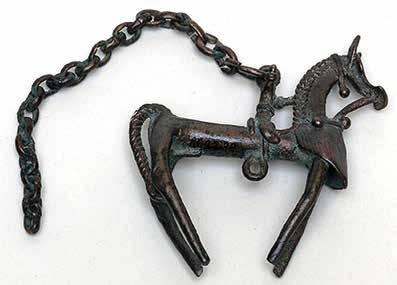
Bronze pendant in the form of a horse. III-I centuries B.C. Nargizava, Agsu.
Bronze pendant in the form of a horse. III-I centuries B.C. Nargizava, Agsu. ders around its native village for several days, enters its home and watches the execution of the funeral rituals. If the ghost of the deceased was satisfied with the sacrifices and behavior of the participants in the ceremonies, it would subsequently assist and protect the relatives, if not, then it would bring distress and illness.
Then, having moved to the underworld, the souls have lifestyle, that differs from the mortal life very little . They live in houses, use the same utensils, weapons, put on jewelries, eat, drink, sleep, quarrel. In the ancient grave inventory of the pagan burials of Azerbaijan household items were found. The presence of them confirms this idea. From time to time, souls remind of themselves and of the living’s duties to take care of them and appear to them in a dream or causing illness.
According to ancient Turkic imaginations, there is special kind of vital force, which son receives from his father, and descendants receive from the ancestors in general. Performing of the ritual of honoring the ancestors with the utmost force of sincerity, with a sense of their real presence on the ritual seemed to stimulate and nourish this life force. Such position promoted both moral and physical prosperity of the pious descendant.
Both on the Indo-European and the Turkic-Mongolian stages of Transcaucasus cultures development, two main directions prevailed in their cult practice. The first direction was presented by the funeral and memorial rituals, which could be some conditionally united by the notion o “cult of ancestors”.
The second direction is presented by the cults of natural spirits, forces and elements worship. Purposeful researches of steppe archaeological monuments left as a result of these rituals, are just beginning. Both of these directions in development of the cult were accompanied by the creation and installation of stone sculptural images. These stone sculptures played dominant role in

cult place and were the embodiment of the materialized ancestor, creator and protector of the kin (demiurge).
The very discovery of them in the big massif of the all steppe culture (which was also spread on the vast steppes of Azerbaijan) is a very extraordinary task itself. The finds of these monuments, as a rule, are few, because of Islam subsequently spread in this region and its long struggle against them. So, collected material can be hardly interpreted for certain.
However, these sculptures are the only reliable evidence of ancient rituals and allow us to look into the past beyond the boundary, after which written sources are known. In addition, the pagan monuments of ancient sculpture built into the landscape became the part of symbolic structure of the modern steppe space.
In imaginations of our ancestors, reincarnation occupied a special place. That imagination was based on ideas about a special life force that exists apart from a person. The same physical appearance belongs both to alive person who is acting, moving, thinking, and to dead, whose corpse looks like a living one, but is motionless, insensible, because the life force (“soul”) has separated from it somewhere.
According to the ancient Turks ideas when a man died, his soul or spirit, left the body like “smoke”. The fate of these spirits, according to the ideas of the ancient humans, was different. Some of them stay on earth, doing good and evil, the other part goes to heaven and continuous to influence over the lives of descendants. It was also believed that the souls of the dead seek their refuge in animals and objects. That’s why many remedial techniques were associated with animals: e.g. headache was treated by placing of puppy on a forehead, in a fever a goat was tied next to unhealthy, etc.
As it’s known, the cultural contacts with the Far East and with Chinese culture particularly had a great influence on the peculiarities of ancestors cult of the steppe culture bearers (the Turks of Eurasia). In this connection, the reasoning of some Confucianists about the ancestor cult nature are quite interesting. As it’s known, Confucius, preserving and exalting the archaic cult of ancestors, filled it with fundamentally ethical content. We do not know whether Confucius himself believed in the immortality of the ancestral spirits or not. Confucius and his students refrained from making judgments in this matter. They said: “We do not know what life is, how

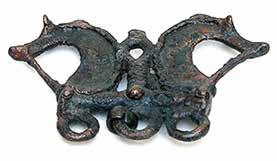
Bronze pendant in the form of two-headed bird. III-II centuries B.C. Nargizava, Agsu.
Bronze pendant in the form of two-headed horse. III-II centuries B.C. Nargizava, Agsu.
Gold figurine Eagle. I century B.C. Khynysly village. Shemakha region
Bronze figurine. Eagle. I century B.C. Ismayilly

can we know what death is” . Anyway, the ancestral fate of the ancestors clearly belonged to the sphere of what the Teacher did not speak about (tzu bu yue). However, the respect for ancestors was prescribed to any of his followers.
What for? Firstly, it was necessary for moral improvement and development of the family-clan virtues of filial piety (siao), highly valued by the Eastern ethics. The second point is that according to Confucian ideas, a son receives from his father (and descendants from ancestors in general) “tsi” (vital force) of a special kind.
Performing the ritual of ancestors honoring with the utmost force of sincerity (chen) and with a sense of their real presence at the ritual (zhu tzai) stimulated and encouraged this vitality. It promoted both moral and physical prosperity of the pious descendant.
It must be pointed out, that concepts of this kind were close enough to the grounding the idea of the existence of certain cults through transpersonal experiences. There is no doubt that in culture of Turkic peoples we observe similar attitude towards ancestors.
In traditional cultures ritual, all cult practice is a form of practical realization of world existential perception. As a matter of fact, it is the main form of human activity for the realization of this world perception in the phenomenal reality.
At the same time, cult practice plays a key part in the functioning of traditional culture system. It’s quite natural, since cult practice expresses the symbolic overcoming of opposites, which are extreme for the human consciousness. The experience of the integrity of being and the integrity of knowledge about being is achieved only in ritual. That experience is understood as a blessing and refer to the idea of the sacred as a bearer of this good.
This experience of existence in all its intensity and in special vital fullness gives a person a sense of his own rootedness in this universe. The

person gets consciousness of involvement in the sphere of natural which is controlled by a certain order blessing. (64.17).
The archaic ritual connected with the veneration of ancestors supposed the participation of all members of the collective. They took part in rituals not only as the audience, but more as participants. At the same time, archaic ritual did not assume severe institutionalization of ritual activity as it happened later.
The “language” of things was used in ritual, mainly to express the ideas, concepts, values that could not be expressed just as adequately in other languages, including using words (23.83).
The compositional and semantic meaning of the ritual was concentrated on the victim, this is his main, secret nerve. Each ritual explicitly or secretly contains a distinct redemptive note (64.38). The main role in the ritual is played by the symbolic meaning of the sacrifice.
That’s why, the sacrifice in the framework of the ritual is not only the ritual murder of an animal or person, not only the offering of special objects or substances. The construction of a ritual structure is also a sacrifice in which the ritual is realized. The monuments, created in the course of ritual activity and for performing rituals (shrines, idols) were important condition for performing the ritual on the one hand, and were its content on the other hand.
Archaic religious monuments, addressed to the veneration of natural forces and elements, differed fundamentally from the later altars and temples of formalized, institutionalized religions. The early, archaic paganism stage was the system of perception and worship to natural forces. It was characterized by the performing of religious practices beyond of specially organized space, in open places, connected with the most impressive natural objects, such as mountains (60.19).
The structures erected at the same time, e.g. sanctuaries, stone idols were as laconic as possible and fit in with the natural system of landscapes very well. As a result, the existentially perceived structure of the world is revealed and become the key objects of this structure.
In pagan cultures, the most vivid, sacredly important objects of the real landscape were selected for the location of religious places which were associated with the worship of ancestors. These places of cult practices implementation were associated primarily with the real objects of the world, surrounded human. That world was perceived as alive, constantly acting, filled with many meanings.
Bronze Lamps (Chiraq). III-I centuries B.C. Chukhur, Gabala.


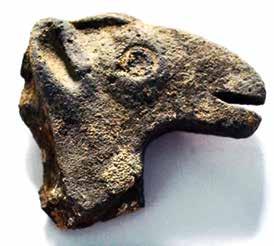
Stone. Man. 1st millenium B.C. Absheron Peninsula. Mardakan Fragment of sculpture of gazelle. Stone. V-IV centuries B.C. Alar village, Yardymly.
The earliest of these monuments (the Neolithic and the Bronze Age) were cult columns. These columns while coming closer to the Scythian era, gradually got anthropomorphic features, more correlated with the image of the human ancestor.
In the steppes of Central Asia sculptural statues, demonstrating both stages of the development of the ancestral cult plastic art are the most vivid evidence of the religious practices connected with the veneration of ancestors. At the same time, to some authors’ mind these stone statues were the object of dead ancestors honoring.
These statues portrayed concrete buried person and were exclusively male one. While progression to the West (including the Caucasus), the statues were connected more and more with imaginations about general sacral or heroic ancestor. As a matter of fact it was abstract forefather, deified mythical patriarch. (71.82)
The peculiarities and character of such rituals, performed in front of statues can be estimated about basing on available evidences of various animals victimization in front of the statue. This supposition is proved by the remains of horse, bull, sheep and dog found in front of the statue. (67.191-192)
Stone figures of people. III-I century B.C. Chenlibel, Shamkir.
a b c 0 10 20 d
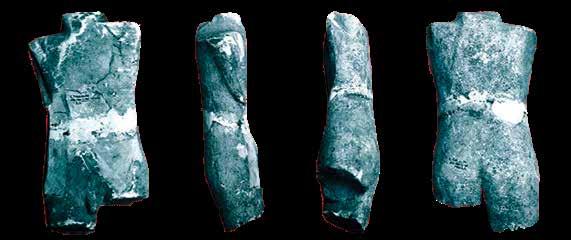
In the Western Turkic steppes ( where Kipchaks lived), the stone statues were worshipped by a wider circle of nomads. To Fedorov-Davydov’s mind in this tradition strong component of the ancestral cult was kept. But that ancestor was not a real, well-known person, deceased recently, but a heroized and mythical ancestor.
That is, to some extent, the stone statue becomes the object of a wide and permanent tribal or kin cult, i.e. the cult of the ancestor. This fact is also emphasized by great Azerbaijani poet Nizami, who spoke about the universality of worship a stone statue.
The stone sculptures, which fell to the west of the Kypchak steppes underwent the artistic metamorphosis. It was connected precisely with a change in their semantics. The double of the deceased gave way to the image of the deity. In accordance with this, a flat stone pillar with lines of the face, hands, etc., scratched on was replaced by an artistic sculptural image. In that image we can find the aspiring to embody the image of a person not in schematic signs, but in plastically expressive forms. So, the stone statue of the conditional “deputy” of the deceased person turns into a kind of idol, which required a certain artistic effect and plastic means to convey its essence.
Obviously, in statues which had the function of a public idol or object of public worship, this particular being of the symbol of the dead corpse gives way to an artistic image. That artistic image has other tasks - to influence over the viewer both emotionally and ideologically. This task could be performed only by art already, in the true sense of the word, with a set of powerful plastic tools.
Among the monuments associated with the cult of ancestors - a special place is occupied by stone sculptures, also known in the archaeological and art critic literature under the inexact, but the traditional name “stone women” (stone
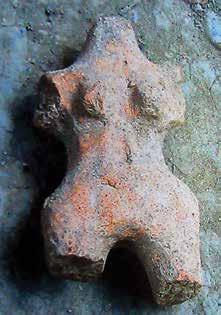
a b c d

Ceramic Woman figurine. III-I centuries B.C. Mingechevir. (a)
Woman Idol. Ceramic. III-I centuries B.C. Qabala (b)
Female ceramic figurines. III-I century BC. Gabala (c, d)
The head of the figure. Ceramics. III-I century B.C. Nargizava, Agsu. bimboes). Thanks to the efforts of well-known turkologists, many different types of stone sculptures of different times are now divided into several cultural and chronological groups. These are the sculptures of the Bronze Age, the sculptures of the Scythian period, the ancient Turkic sculptures and the Kypchak-Polovtsian statues of the southern Russian steppes.
The ancient Turkic sculptures (VIII–IX centuries) present one of the largest groups. In this group the statues, widely spread in the vast mountain-steppe spaces of the Caucasus, Central and Central Asia, in the territories of modern Mongolia, Tyva, Altai, Sinkiang (China), Kazakhstan and Kyrgyzstan are included.
Many of these stone statues for a long time were considered to be tombstones. However, special archaeological researches established that there is no direct connection between people buried in burial mounds or graves, and the statues standing on them, because they are later structures. It was proved that this peculiarity applies to the entire steppe, inhabited by the Turks. The ancient Turks had the custom to build stone

statues . Such sculptures were placed not on the graves, but apart. (68.91).
In early medieval stone sculptures of the South Caucasus (Aqdam, Terter, Shemakha) usually standing men with their hands folded in a prayer pose is pictured. Only one, Shemakha statue depicts a man holding a vessel in his right hand.
In medieval sculptures of Central Asia mainly sitting men of Mongoloid appearance with a high cheek-boned face, slanting eyes, very often with a mustache and a beard is pictured. On separate sculptures there earrings put in the ears and smooth torques and necklaces around the neck are painted.
On many sculptures clothes are shown, e.g. various types of hats, gowns and caftans with lapels on the chest, narrow or wide sleeves with cuffs. On a narrow belt, formed by means of various plagues dagger and sword in scabbard, as well as handbag, sharpened, and other objects are suspended. Almost all the statues hold a vessel in their right hand, the left one, as a rule, is pictured lying on a belt or weapon.
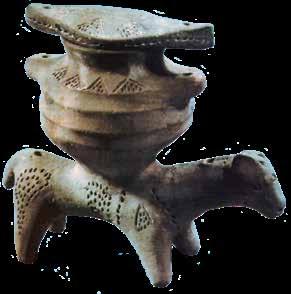

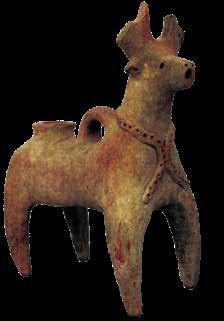

Ceramic vessel in the form of a deer. End 2nd milltnium B.C. Mingechevir.
Zoomorphic ceramic vessel in the form of a deer. III-I century B.C. Nargizava, Agsu.
Ceramic rhyton with protome unicorn. IV-III century B.C. Mingechevir
Ceramic vessel in the form of a mountain tour figure IV-III centuries B.C. Mingechevir

Red ceramics in the form of a deer. I century B.C. - I century A.D.
MingachevirCeramic zoomorphic vessel in the form of a goat. IV-III century B.C. Mingechevir.
A large number of stone statues, discovered in the steppe expanses, testify that their production was established widely. At the same time, more than half of Central Asian (and almost all of Azerbaijani) stone statues are made on specially selected stone blocks, which already look like the outlines of a human figure.
Such anthropomorphic blocks were cut for greater similarity, their faces were rounded off by beating and subsequent polishing. The bent boulders of elongated form were used very often and successfully, as can be seen in a statue from Absheron (Turkan village).
On the smooth surface of such stones, as a rule, only the most general contours of the figure were applied by means of a point beating technique. Apparently, there were no workshops as such, but in the Caucasus and Altai there are a lot of stone quarries created by nature itself. Dozens and even hundreds stone blocks and slabs of regular rectangular shape lie in the faults. They were used for making sculptures basically. Techniques of sculpture and tools, applied in general were probably the same for the masters of the Caucasus, Altai, Tyva, Mongolia and Semirechye, as the stone statues are monuments of a single circle of medieval nomads.
In addition, these are monuments of a cult character, in which not only the iconographic features of the ancient Turkic sculptures were canonized, but the basic techniques also remained conservative. This is seen quite clearly if compare stone statues found in various distant regions of Central and Middle Asia, as well as the South Caucasus.
The use of these idols in the rituals, dedicated to the veneration of ancestors is documented in a number of sources, among which the synchronous source of the early Middle Ages can be considered the most authentic. This source is “The History of Caucasian Albanians” by Movsēs Dasxurançi (50.)
Comparative analysis of stone statues reflecting the cult of ancestors in the vast expanses of

Asia and the Caucasus testifies a common ideological roots of the steppe culture bearers. The semantic kinship of these statues was accompanied by the development of stylistic features. Those features reflected the ethnocultural features ascending from stone pillars to anthropomorphic faces manifested ethnic types of appearance.
Sculptural arts of funeral rituals
In traditional cultures ritual (cult practice) is form of practical realization of world existential perception. Such rituals are the main form of human activity on embodiment of phenomenal reality of that world perception.
So, cult practice plays the key role in traditional culture functioning. It’s quite logical, because in that practice symbolic overcoming of oppositions, extreme for human conscience is expressed.
In ritual the human being can feel wholeness of existence and wholeness of knowledge about it. That knowledge, that wholeness was perceived as blessing and connected human being with sacral idea which was a bearer of that blessing. So, the human being passed through those emotions in all it’s intensity, in special life fullness. Those emotions gave human the feeling of his own rootedness in society, understanding of engagement with sphere of regularity, ruled by definite order. (64.70)
To P.A.Florensky’ mind initially all human activity was penetrated by deep sense, it was always of ritual character ( in author’s terminology – “theurgical” one). When the unity began to disintegrate, “theurgy” reduced to ceremonial actions. As a result “ the activity turned from supreme Reality and Sense to realities and meaning Everything became similar to Truth and
Ceramic vessel with ram figurines. IV-III centuries B.C. Mingechevir
Dish with ram heads. 1st millenium B.C. Mingechevir.
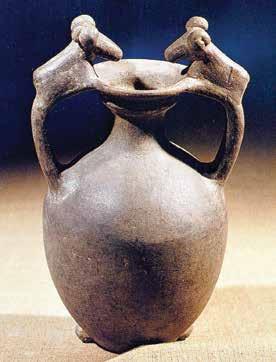



a b c d
Ceramic idol. 1st millenium B.C. Baku. (a)
Ceramic figurines. III-I centuries B.C. Molla Isakly village. Ismayilly. (b)
Ceramic woman statuettes. 1st millenium B.C. Molla Isakly village. Ismayilly.(c)
Ceramic Woman Idol. 1st millenium B.C. Shaki (d) stopped to be Truth itself, to exist in Truth. In which he took part while alive. As a rule, if the word, everything became secular one.” (64, 55). deceased had killed one man, one stone was put. The ritual is primary, archetypal form of human But sometimes, the number of such stones can activity, it’s most ontologically filled form. This be hundred, even thousand. (26, 179). fact was shown in A.K. Bayburin’s works very Thank to long years activity of some archeolconclusively. To A.K. Bayburin’s mind “it’s argua- ogists ancient Turkic graves and epitaphs were ble that technology wasn’t accompanied by ritual found. The content of epitaphs confirms Chinese actions, on contrary, just ritual itself created tech- information completely. Nowadays, we know nology”. (23.68). well enough what means the cavalcade of stones
There are numerous mentions about charac- at Orkhon Turks graves. These stones are worked ter of funeral habits performed Turkic tribes in roughly, and as a rule they are simple stones- ancient and early medieval period .Sometimes, “balbals”, means the pictures of killed enemies. these mentions contradicted each others. But worked up graven images pictured the dead,
The earliest written testimonies about Turkic his relatives or family members. funeral habits were given by Chinese. In Chinese Except Mongolia balbals and stone images historical chronicle Tan-shu ancient Turkic fu- are known in Altai, Tuva, Kazakhstan, Caucasus. neral ceremony is described in following way: (33, 86). In these regions balbals are connected “ In building, erected on grave they put the pic- with small stone fences, which were cult plactured face of deceased and picture of battles, in es. Near eastern part of fence the stone image is


standing east-facing. Sometimes, alike Orkhon Turks graves, the ranks of simple stones –balbals- were placed to east from fences.
In the same time, the stone statues, which are sculptural portraits of deceased, are worked up carefully and delicately. Inside fences even the traces of human burials are met no once, only round holes, filled by big stones and powdered up by sand, coal, ash were found. Closer to bottom the remains touchwood are met.
In holes animal bones were found also, they are found in all space of fences. Such fences, alike buildings at graves of dead Turks, mentioned in tan-shu, were also the place of deceased commemorating. So, the bones, things, ash and others are the remains of commemorating bringing. Near the fences the barrows with burials of VIIIX centuries are placed.
Between ancient Turks in Orkhon, Altai, in Tuva and Kazakhstan from one side and East-European Turk speaking tribes of X-XIV centuries from other side very long historical epoch passed. Certainly, in that period ancient Turkic ritual transformed, but it’s main characteristic features were saved. It’s seen in habits of Polovtsians most clearly. Complicated burial complex of Polovtsians in general is similar to one in ancient Turks.
Ceramic figurines. III-I centuries B.C. Molla Isakly village, Ismayilly
Ceramic Woman figurine. I century B.C. Khynysly village, Shamakhy
Ceramic figurines. I-III centuries A.D. Shaki.
Ceramic figurine. I-III centuries A.D. Shaki
Womans Idol. I-II century A.D. Khynysly village, Shemakha
For characterizing burial traditions of Turkic tribes of X-XIV centuries interesting material can be taken from works by ibn-Fadlan, G. Rubruck, Plano Carpini and other historians of that time. All these works in some parts complete and improve the description of funeral habits of ancient Turks.
Rubruck could do very interesting ethnographical outlook among Tatar-Mongol and Turkic tribes, though didn’t know their languages. So, Rubruck gave them different ethnical characteristics.
E.g. description of burial ritual of comans (polovtsi), their graves-barrows, stone statues and other terrestrial constructions, which he saw in way to Karakorum is of great interest.
“Comans pour small hill above dead and erect east-facing statue with bowl in his hands in front of belly-button. For rich men comans also built pyramids, look like little pointed houses. In some places I saw big towers made from bricks, in some places stone houses, though in that area stones are not found.
I saw one newly dead. Near him comans hung 16 horsy skins, four ones from each compass points. In front of dead they put kumis to drink and meat to eat, though they said, that dead was Christian. Then I saw other burials in East direction. They were big squares, paved by slabs of stone, some of them were of round form, others- of quadrangular form. There were also four long stones, erected from four sides on front side of square. (16.102-103.)
Archaic ritual (at the least, the main for this tradition) suppose the participation of all members of collective in it, and all of them were not spectators, but participants first of all .



Ceramic Woman figurines. I-III centuries A.D. Fizuli region
Ceramic Figurines. I-III centuries. Chukhur Qabala village, Gabala region
0 1 2 3 cm

0 1 2 3 cm
The single menhirs, alignments and menhirs complexes are also included in group of megalithic memorials of steppe Transcaucasus. As follows from investigations, carried out last years archeologists succeeded to bring to light more than thirty memorials of such type. As a rule, these memorials are placed in a short distance from settlements, more rarely-near burial grounds of Late Bronze age. Single menhirs of steppe Caucasus are placed either near back-arc commissure of terrace above flood-plain or in lower part of valley-wall upland. The most part of menhirs complexes takes the same position. Alignments in most cases are placed topographically higher, on the sides of hill. The great majority of single menhirs and their complexes are erected in short distance from Late Bronze age settlements.
The distance between menhir and the nearest housing dimple is from 40-80 meters in main part. Maximal height, fixed above modern surface near single menhir with standard topographical location was 1,9 meters, maximal general height-3,15 meters.
The alignments are always stretched in WestEast direction (with little divergency) and are the one line of stones, set vertically. Most of them were dropped or broken already. That’s why correct reconstruction of avenue structure is possible only after it’s excavations.
The main part of single menhirs rise on the height approximately 1,5 meters above ground. In avenues menhirs 1,5 meters high above ground are fixated. We can suppose the connection of alignments with cult of steppe ghosts respect. This interpretation can be confirmed by fact, that alignments are placed in zone of straight visibility. As a rule, they were placed to the South from most noticeable top in neighborhood.
Single menhirs and menhir complexes were erected in the Late Bronze Age by Indo-European inhabitant of steppes near with long-duration settlements. In all cases menhirs were set in some

Ceramic Woman Idol. I-III centuries. Khynysly, Shemakha region
Bronze figures. I-III centuries A.D. Ibrahim-Hajyly village, Tovuz region.
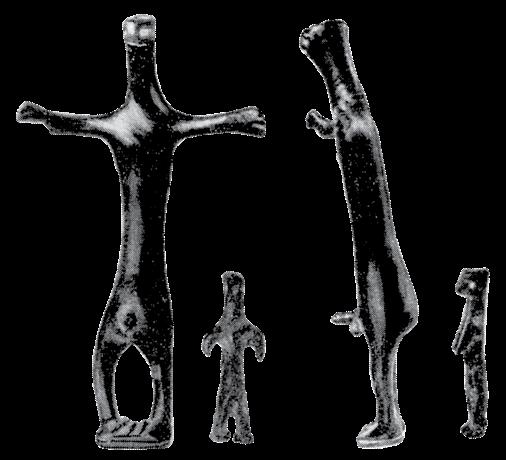
Clay figurine of a woman. I century B.C. Mingechevir distance from dwellings and were some higher than them. So, menhir marked the border between steppe and human dwelling place.
The analyses of mentioned memorials topography demonstrates, that all of them were erected in directions, more suitable for approaching to settlement. This fact let suppose, that menhirs were erected near roadways, leading to settlements. Such location was reasonable, because just the roadway was the element, connected settlement with territory around it. So, that element had to be marked by boundary sing.
The symbolic of menhirs can be interpreted as binary one, comprehended the opposition of assimilated and unassimilated space. From steppe side menhir was placed some higher than settlement and from long distance looked like symbol

of human dwelling, the symbol of anthropogenic space beginning. As for settlement side, the menhir is symbol of steppe power, stretched behind it. May be the deficiency of refinement on those stones can be also explained by natural aspect of menhir symbolic. The boundary position of menhir between human dwelling and world, sur-

Clay figurines of women. I-II centuries of A.D. Molla Isakly village, Ismayilly
Bust and head of clay figurines. I-II centuries of A.D. Molla Isakly village, Ismayilly
Clay figurines of womens. I-II centuries A.D. Molla Isakly village, Ismayilly.
Clay figurines of womens. I-II centuries A.D. Molla Isakly village, Ismayilly

rounding it means, that menhir had a symbolic meaning of guard, who locked the landmark and protected the dwelling. So, the guard had to stand near the roadway, which was the symbol of connection between two worlds.
In this regard the problem of interpretation of Turkic balbals, discovered in territory from Black Sea to Altai mountains places, i.e. in places where our pagan ancestors settled and widely spread is of great interest.
First of all it’s necessary to admit, that the lines of stone small columns (fences) are inherent part of burial constructions of ancient Turks and are codenamed Turkic balbals. These balbals, known all over the ancient Turkic world, are the object of scientific polemic till the present day. From other hand, confirmed opinion about the explanation of term “balbals” can be considered as serious progress in this problem decision. ( to some specialists mind, the word “balbal” is deformed form of Turkic “baba”- father, ancestor.)
The results of last scientific investigations of well-known archeologists L.R.Kyzlasov, Y.A. Sher and S.G.Klashtorny brought to close the discussion about the meaning of word “ balbal”. As it’s known, earlier in professional (specialist) literature the stone statues themselves were also called “balbal”. But now, that name is used for definition of stone fences (columns) lines, getting out to the East from burial constructions.
All preceding investigators (upwards Herodotus) are united in the point, that Turks erected stone fences (columns) – “balbals” near burial constructions of their ancestors in accordance with number of enemies, killed by deceased himself. Such conclusion is based on information, got
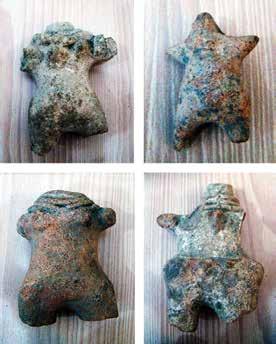
from official Chinese chronicles, in which burial ritual of ancient Turks, called “tuku” is described.
“As a rule, if he had killed one man, one stone is set, but in some burials the number of such stones was hundred, even thousand”. Really, some lines of ancient Turkic burial constructions count tens, sometimes hundreds “balbal”. (42.206-209).
Setting of large number of balbals near almost all memorial complexes of ancient Turkic aristocracy logically caused consternation of many specialists. It’s difficult to imagine, that Turkic Kagans or their military officials could kill hundred enemy warriors. Besides, in Altai near thousand fences there are always many lines of balbals.
So, a question suggests itself- is that so, all these balbals were set only in honor of ancient Turkic warriors? To our mind, for explanation of balbals erecting tradition not only written sources, but factual archeological-ethnographical material must be used in a greater degree. The tradition of setting of stones in lines in Altai and in all Turkic oecumene is very ancient.
This simple architectural theme, differed by rare monotony is embodied in many cult constructions, quite different by time and purpose. The lines of stone steles, set from eastern side of many barrows of early nomads are most close to ancient Turkic balbals. The placing by means of “barrow chains”, directed from North to South is the characteristic peculiarity of pagan burial grounds. The same principle of planning and orientation is kept in erecting of large groups of pagan fences of ancient Turkic period.
Alike barrows of early nomads, those balbals copied the placing order of dwellings in small season settlements. This feature is displayed most clearly in orientation of memorials in definite area. The appearing of such burial-commemorative complexes as special territory, intended to funerals and memorials, demonstrates the ethnic community, family relationships and idea of further existence in other-world.
The purpose of balbals placed near barrows of early nomads isn’t known. But there is supposition, told by outstanding archeologist I. Rudenko which is also worth noticing. To I. Rudenko’s mind the number of stones, set near graves corresponds to number of persons or relatives, took part in funeral and death feast.
Developing the idea, I. Rudenko came to conclusion, that the lines of balbals could stand
0 1 2 3 4 cm
Clay figurines of saddled horses. I century A.D. Molla Isakly village, Ismayilly

Brooch in the form of a stag. I-II century A.D. Caucasus Mountains region. Metropolitan Museum. also near graves of women and children. So, their number cannot be connected with number of killed enemies. That conclusion was confirmed by researches, made last years. But what was the purpose of Scythian balbals near Altai and other steppe barrows? To our mind, they were symbolic horse-standing columns, which were the inherent part of nomadic dwelling.
The ancientness of horse-standing columns erecting near graves is mentioned in Herodotus works also. Archeological excavations confirmed that knowledge. The remains of numerous horse-standing columns were found in researches of Elizabethian and Ull barrows in the Kuban. Similar balbals were discovered also in steppe zone of Azerbaijan.
In Altai the functions of horse-standing columns were fulfilled by the columns, also called “balbals”. Our supposition is based on similarity of balbals placing in Altai barrows and fences to order of horse-standing columns near real nomadic dwellings. The lines of horse-standing columns were set near nomadic dwelling, faced to South or East direction. The same principle is seen in balbals setting also. E.g. among the Yakuts the first column was intended for horse of most respected guest, it was called the “main one” – (“toyon serge” -overlord column); the second column was intended for middle class guest (“ort serge”- middle column); the third column was set for low-lived guests (“kelin serge” - back column); most distant column was called “atakh serge”.
In most Altai barrows of Scythian period and near ancient Turkic fences also one or two-three nearest stones as a rule stand out of other ones by their big size. Rich Yakuts sometimes set the line of nine horse-standing columns. So, the wealthy nomads set several horse-standing columns, but poor Yakuts did with one horse-standing columns.
Such social differentiation can followed up both in construction of ancient burial-commemorative constructions and number of balbals in them. In outsized barrows of ancient Altai noblemen the number of balbals- horse-standing columns are in large excess over the balbals, set near the small barrows of ordinary nomads. Similar picture is watched while comparing balbals set near burial-commemorative temples and near ordinary fences.
So, the name of horse-standing columns coincide in many nomadic peoples. E.g. Yakuts, Mongols and Buryats called these columns “serge”.
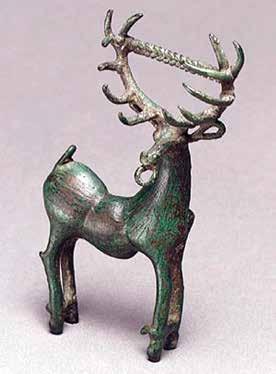
Bur the second meaning of word “serge” is also of great interest for us. E.g. Yakut –“serge”- line; Buryat- zerge- line; Azerbaijani - “jerge” -line; Mongol - “erge”- line, order; Turkic- “arga”- line, round. There is doubt, that all these terms trace their origin to ancient Turkic epoch.
Thus, balbals can be considered as horse-standing columns, intended for horses, on which relatives and guests came to take part in burial- commemorated ritual. It seems, that balbals- horse-standing columns were in main part original sign of respect and attention or presence of definite person in funeral.
To our mind, the existence of personal tamgas and inscriptions-autographs, discovered on balbals set near commemorated temples of ancient Turkic kagan can be explained by this fact. In other words, every participant of burial-commemorated ceremony left (set) his own balbal, towards the ghost of dead man could see it in line of similar courtesy. (43.46-52).
The considerable number of specialists basing on big factual material came to conclusion, that fences of ancient Turks had sacrificial character and here rituals, connected with funeral, e.g. “feeding” and dead ghost farewell in other world were performed. (41.162-187)
The stone fences, found in Azerbaijan are of two kinds-round and quadrant form. The round fences genetically trace their origin to barrow culture, widely presented both in Apsheron and Mil steppe. As for quadrant fences, they trace their origin to cemeterial constructions of “box” type, which were also widely spread in territory of Azerbaijan.
Plastic characteristics of balbals initially were in germinal condition, and reflected the matter of

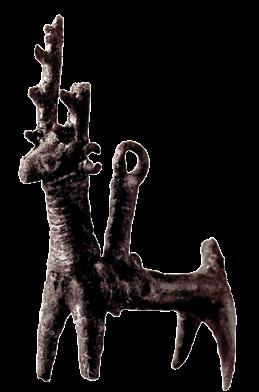
Head of a man. Amber. I-II century A.D. Mingechevir
Female goddess in the form of a cat (Bastet). I-II centuries A.D. Ganja
Bronze pendant in the form of a deer. I century B.C. Mingechevir


commemorating ritual ideologically. Sculpture idea was expressed implicitly in them and didn’t get the level of anthropomorphic plastic modeling, expressed explicitly.
Totemistic cults and their reflecting in sculptural art
Totemistic beliefs or totemism – is belief in fact, that definite kinds of animals, plants, some material subjects and phenomenon of nature are the ancestors, forefathers and protectors of concrete tribal collectives. The belief in initial mystic con-
Copper figurine of a bird. I-III centuries A.D. Agsu
Detail of a bronze candlestick. I century A.D. Lachin, Karabakh region
Silver brooch. I-III centuries A.D. Demirchilar, Shemakha


nection of tribe with some animals is seen in all Turkic peoples and in pagan ancestors of Azerbaijanis. Such beliefs are called in science “totemism”. (“Totem”, “o-totem”- tribe, his tribe, the word, taken from language of one North American Indians.)
Totemic animals and plants are real material objects. Fantastical element here is based on idea about relationship, which supposedly exists between some animal or plant and group of humans and on idea, that the human being has magic connection with his totem.
In the same time, totem isn’t the only object of totemic beliefs. The main important ideological role of belief in totemic ancestors and mythes about them lies in the fact, that in them the connection of tribe with definite territory is embodied. The mythes about totemic ancestors are attached to separate part of geographical landscape. Totemic ancestors also function as “cultural heroes”. The traces and relicts of totemism are discovered in different degree in different modern religions and were saved as elements in ethnic cultures of many peoples.
The greater part of religion scholars seem to think that totemism is one of earliest form of religion because of it’s prominent primitiveness and because they formed the basis of religious imaginations almost all Turkic peoples.
In religious studies, culturology and art criticism totemism is famous due to two quite different scientific works- “Totem and taboo” by Z. Freud (1912) and “About some initial forms of classification: towards study of collective imaginations” (1903) by E.Durkhame and M.Moss. These books became classical sample of sociological approach in modern religious study.

Ceramic Rython. I century B.C. Mingechevir
Fragment of a zoomorphic vessel. I century A.D. Mingechevir
Anthropomorphic (Woman) vessel. I-III centuries A.D. Khynysly, Shemakha
Female ceramic idol. II century B.C. –II century A.D. Yevlakh

As a rule the term “totemism” is understood as imaginations, suppose the presence of collective relationships between group of men (e.g. tribe) and definite kind of animals or plants (sometimes- unanimate things – mountains, rivers, seas etc.)
Totem (e.g. totem animal) is considered to be ancestor of human group and object of worship. As a rule totem is forbidden to kill and to eat, though some rituals, on contrary, suppose killing and it’s cult eating. According that rituals such eating strengthened blood ties by means of secondary inclusion to totem.
Sociological school in culturology considers that religion ideas (in early societies particularly) first of all have the aim to organize the society, and it’s division into groups or classes is projected in sphere of ideas. So, this school considered totemism as projection of archaic structure of society, divided into separate groups, which are connected with different totemistic ancestors.
From other side, M. Eliade uprightly pointed out (74.200) the presence of parallelism between structures of society and structure of universe. To M. Eliade’s mind as a matter of fact that parallelism acknowledges the existence of unified principle of structuring. That principle is immanent to mythological, most archaic intellection, but it doesn’t mean social conditionality of that structuring.
Besides, in the academic circles the fact is known well that the same peoples unless totems

have other, more rational forms of classification. But in all cases totem functions as marker of classification lines, by means of which archaic human regulated the content of his experience.
Such archaic classification didn’t disappear completely together with primitive societies, but embodied itself in history of human civilization in very refined forms. As a matter of fact to authorative sinologists’ mind that classificionism and numerologism undoubtedly form the methodological basis of all classical Chinese philosophy and has the same nature with totemistic regulating structures. E.g. the primary element (u sin) of Chinese cosmology marks or codes quite long classification lines and regulate harmonically the universum (macrocosm) of Chinese culture. (38.172). Totemism also includes very curious rituals, supposing (except mentioned ritual eating of totem meat) identification of ritual participants with totemistic animals or plants.
The study of folklore and folk rituals in Azerbaijan confirm that totemistic cults were performed in ritual practice of our ancestors since Neolithic epoch (IV-III millennium B.C.). Earliest figurines of animals, made in order to carry out rituals also confirm this fact. Those cults are presented in sculptural figurines of Bronze age (III-II millennium B.C.) more widely. The forming of clan system, extraction of tribes from large clans was accompanied by forming of different tribal totems cult. In initial stage these totems played the role of tribal identification, based on principle “friendly-strange” (friend – or foe). With time, while developing and adding new functions those totems began to function as sacral protector of clan or tribe. The rituals of totem worship transformed into one of main cults and were accompanied by making of totem slatterns, later by making of their sculptural surrogates.
Wide spreading of totemistic cults in Azerbaijan is reflected in numerous pictures of totemistic animals on gun and everyday household appliances (ceramic, belts, adornments, talismans etc.). But production of sculptural figures of to-

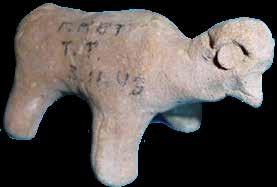
Silver Dish. II century A.D. Yenikend village. Ismayilly.
Clay figure of a ram. III-VI centuries A.D. Mingechevir
Clay figures of womens of the Albanian period. Museum of Ethnography and Archeology. Baku
Bronze Human Head. III-I centuries B.C. Baku

tems from clay, stone, metal and ceramics is most interesting phenomenon.
Bronze figurines of deer, ox, birds and other animals, found in Nakhchivan, Mingachevir, Khanlar and other regions of Azerbaijan gives the testimony to wide spread of totemistic cults in Azerbaijan territory already in epoch of Middle Bronze epoch ( 2ndw millennium B.C.).
There are also numerous evidences of that cult spreading in the Iron Age (1st millennium B.C.) discovered both on Northern Azerbaijan (Karabakh, village Dolanlar Ismayilli region) and in Southern Azerbaijan (Hasanlu).
The great number of totemistic zoomorphic samples of plastic art is connected with Alban period (IV c.B.C.-VII c. CE). Archeological findings in Ismayilli, Masalli region, Quba and other places prove, that this cult wasn’t moved beyond even in early medieval period.
The large majority of these sculptures have the cult character and was used for performing of different totemic rituals, providing totemic protection of tribe, clan, even separate family. The main

part of such figurines were found in different cultural layers of settlements.
The second, very numerous group of sculptural and relief pictures of totems was on different adornments and personal talismans. As a rule, they are of small size and prepared in stylized form. On such things sometimes whole figure of totemic animal is substituted by it’s definite part ( horn, hooves, claw, wing, head, etc.) The figurine of eagle (4 sm) from village Khynysly (Shamakhi region), the figurine of mountain wild ox on the top of bronze pin, figurines of birds on tops of pins from Mingachevir, the head of ox on top of bronze pin top from Karabakh, bronze charms of wild goat and oxen form found in “Yeddi-Tepe” (Fizuli region) and other things are also of same kind.
It should be also noted, that cult of totems, formed during millenniums wasn’t moved beyond even in medieval period, i.e. in period when monotheistic religion Islam confirmed in this region. Islam religion fought against pagan vestiges, but couldn’t oust from religious-mythic subconscious the belief in sacral connection with totemic animal and special protect of that animal.
The pictures of animal on banners of Kara-Koyunlu and Ag-Koyunlu tribes, the pictures of lion and ox head as talisman on gate of Baku fortress (Gosha Gala gapisi), the same pictures on household articles are bright confirmation of this fact.
The most important ideological role of belief in totemic ancestors and myths about them was that in them as though the connection of tribe community with territory of inhabiting was embodied. As a result, the myths about totemic ancestors in some cases were connected with separate part of geographical landscape, it’s also reflected in toponymy of Azerbaijan.





